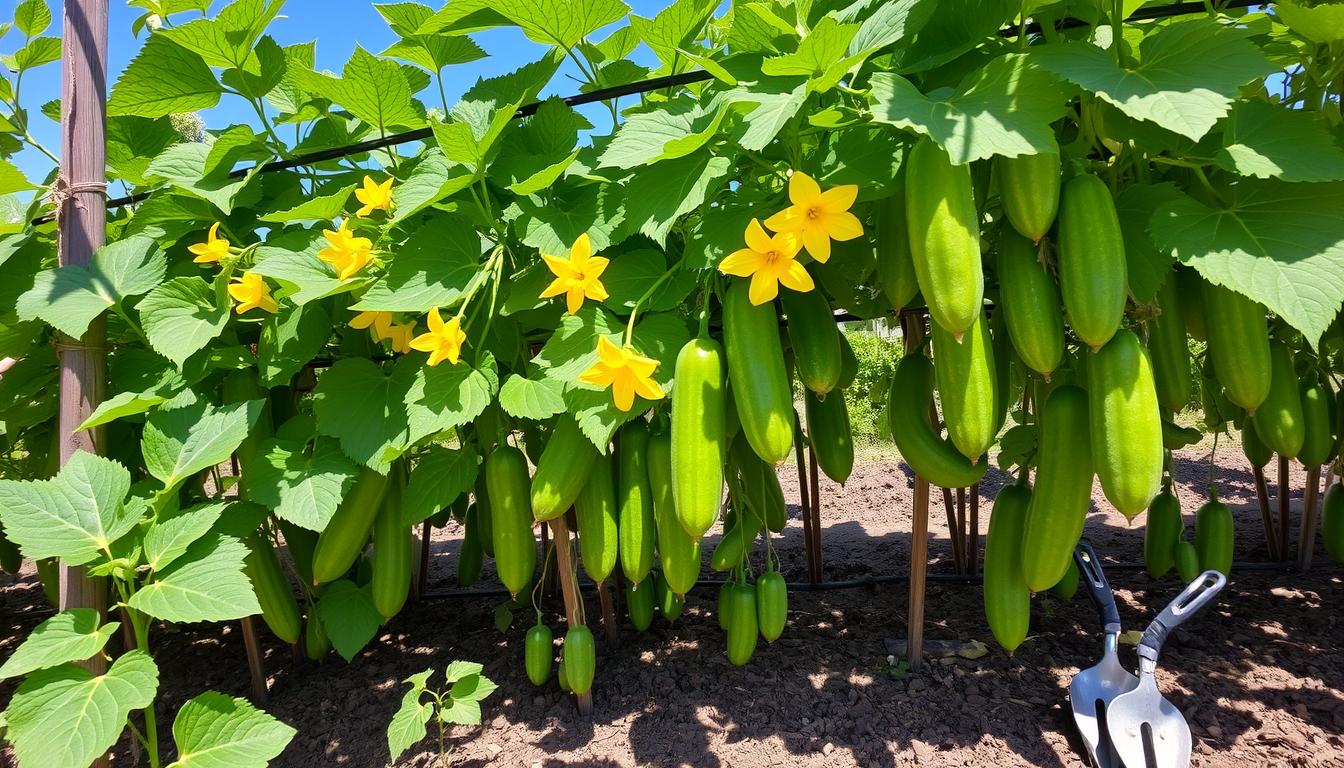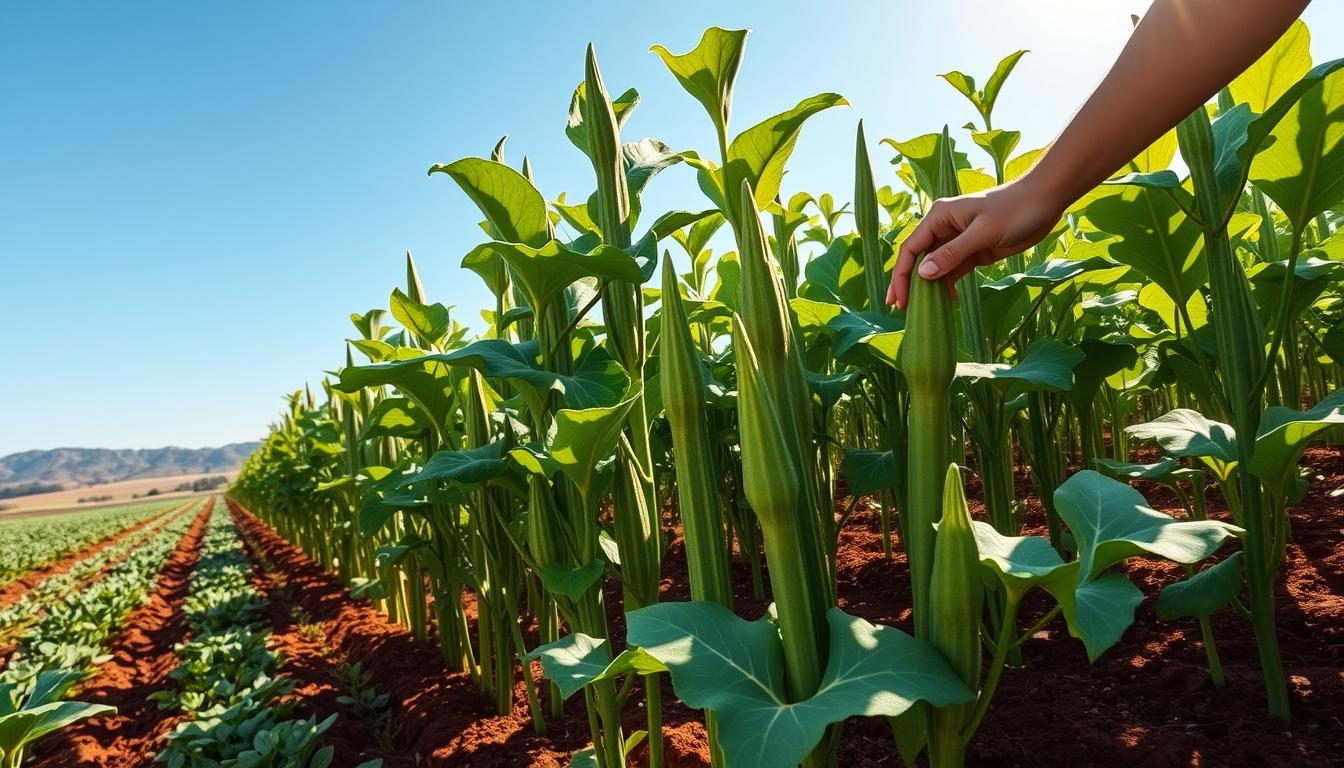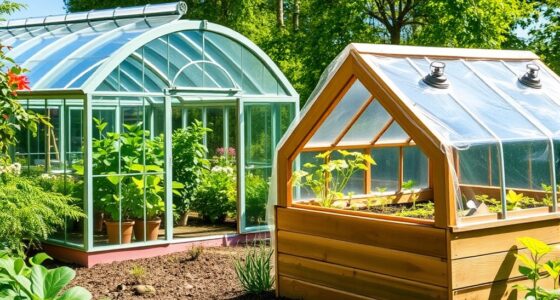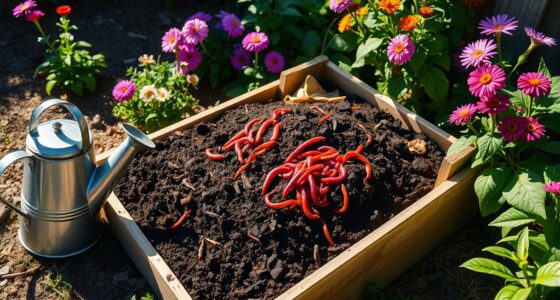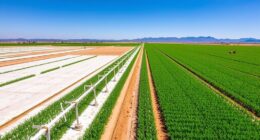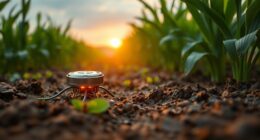Have you ever tasted a freshly picked cucumber? Its crisp, cool texture is full of flavor. This experience ties you to the earth and the joys of gardening. When you start growing cucumbers, you’re beginning a special journey. You’ll see your garden transform and your soul will sing. This guide is for beginners. It gives you important tips for a successful cucumber crop. Your meals will improve and you’ll feel proud.
Key Takeaways
- Cucumbers love warm weather, best between 75°F and 90°F.
- Don’t plant cucumbers where similar crops grew in the last three years. This helps with pest control.
- Keep watering consistent, giving them about 1 inch of water every 5 days to grow well.
- Try growing Gynoecious cucumbers for more cucumbers.
- Pick your cucumbers every 2-3 days to keep them tasty and crisp.
- Select soil that is well-drained, like sandy or silt loam, with a pH of 6.0 to 6.8.
- Using organic methods to manage pests can protect your cucumbers.
Introduction to Cucumber Gardening
Cucumber gardening is great for beginners and experts. It’s rewarding to grow cucumbers because they love warm weather. They need soil around 70 degrees to grow best. Cucumbers grow quickly, usually ready in about six weeks.
Cucumbers are flexible in the kitchen. They can be used in salads, pickles, or eaten fresh. To have a healthy cucumber garden, it’s important to know about planting. Right spacing, enough sunlight, and good soil are key.
If you don’t have much space, try bush cucumbers. They fit in containers. For more fruits, vining cucumbers are best in big gardens. Bonnie Plants® shows how popular and reliable cucumbers have been for over 100 years.
| Cucumber Variety | Growth Habit | Optimal Growing Conditions |
|---|---|---|
| Vining Cucumbers | Vertical growth, requires support | Need good sunlight, fertile soil |
| Bush Cucumbers | Compact, good for small spaces | Full sun, can grow in containers |
To do well in cucumber gardening, planning is everything. You must prepare the soil and take care of the plant. Once you know the basics, growing cucumbers is fun and rewarding. With the proper methods, enjoy the taste of fresh cucumbers from your garden all season.
When is the Best Time to Plant Cucumbers?
The right time to plant cucumbers is key for a great harvest. Usually, the best period is late spring to summer, about one to two weeks after the last frost. Knowing your cucumber planting schedule helps you plant at the right time.
Cucumber seeds need warm conditions to grow. The soil must be over 65°F for them to sprout. If the soil is colder than 60°F, cucumbers won’t grow well. Aim for daytime temperatures between 70°F and 95°F. Night temperatures should stay above 50°F for the best growth.
When planting cucumbers in spring, put seeds in the garden when the soil is warm enough. Starting seeds indoors? Do it 3 to 4 weeks before you move them outside. This approach can give you a longer growing season and more cucumbers.
If you want more cucumbers, consider planting them in cycles. Planting a new round a month after the first can give you cucumbers into late summer and fall. This plan works well with a good cucumber planting schedule. It means more sweet, crunchy cucumbers for a longer time.
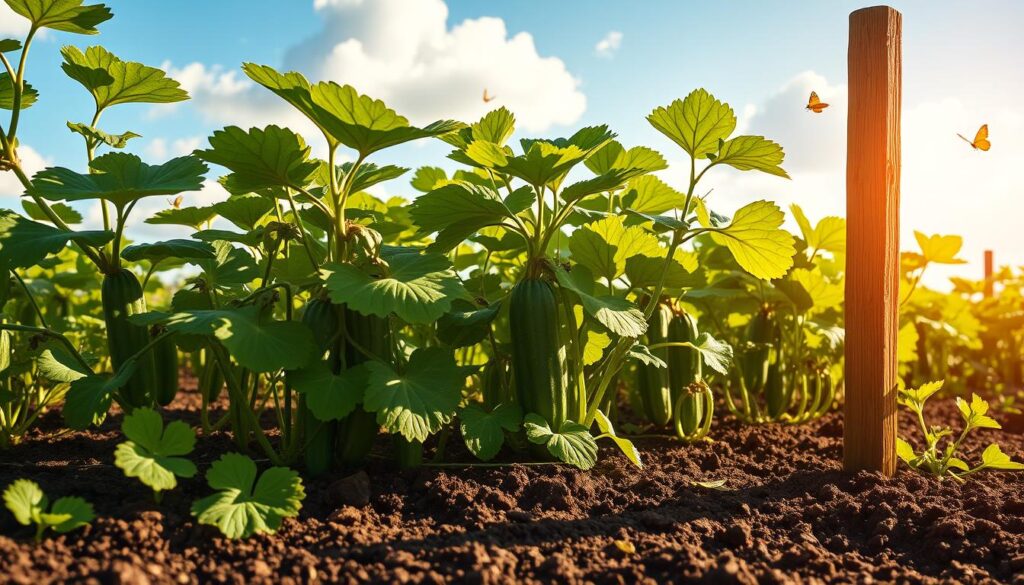
| Temperature Range | Effect |
|---|---|
| Below 60°F | Low germination rates |
| 60°F to 70°F | Marginal germination |
| Above 70°F | Optimal growth |
| 70°F to 95°F | Ideal for cucumbers |
Keep an eye on your local weather and frost dates. With some planning, you’ll pick the perfect time to plant cucumbers. This makes for a satisfying gardening journey.
Best Conditions for Growing Cucumbers
Understanding how to grow cucumbers successfully is key. These veggies like rich, well-draining soil and plenty of sunshine. They need more than six hours of sunlight daily. Also, the soil temperature must be above 65°F for seeds to sprout well.
Watering your cucumbers right is crucial. Make sure they get water regularly, especially when they flower and bear fruit. About one inch of water each week is what they need. Drip irrigation is a great way to keep leaves dry and avoid fungus.
Using a trellis for cucumbers has its perks. It supports the plants and cuts down on disease and fruit rot. For growing in pots, choose one that’s 5-7 gallons for each cucumber. Keeping humidity around 60-70% RH is best for growth, and make sure the air moves freely.
Dealing with pests like cucumber beetles and pickleworms is part of the job. Natural defenses, such as companion planting with nasturtiums and garlic, can protect your cucumbers. Paying attention to these tips will help you grow strong and fruitful cucumber plants.
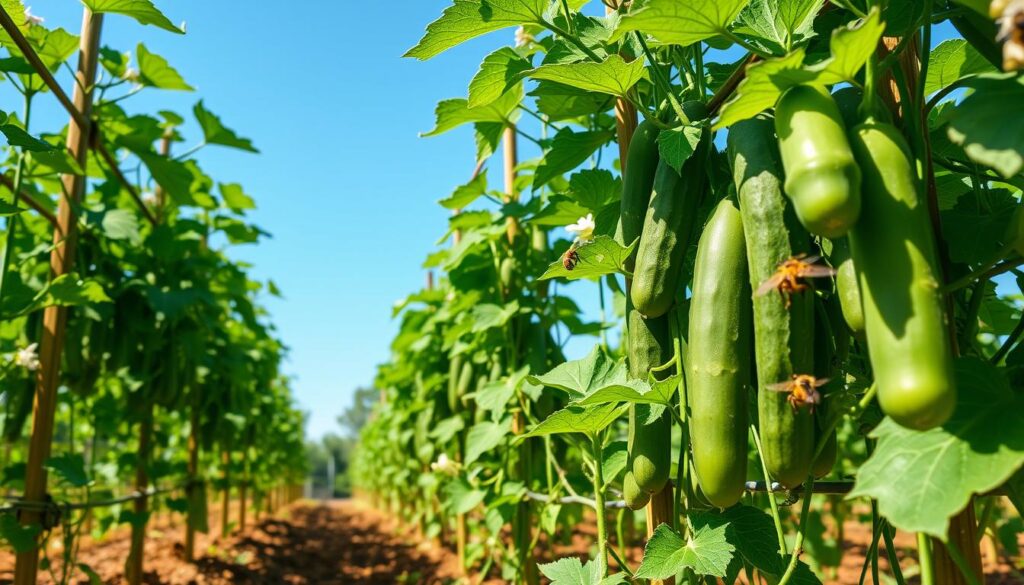
Soil Preparation for Cucumber Plants
Getting the soil right is key for growing cucumbers. These plants need fertile, well-drained places to grow. By knowing the cucumber soil requirements, you can grow healthy plants and get more cucumbers. The right mix of soil and organic stuff makes for great growth.
Selecting the Right Soil Type
Loamy soil, full of organic matter, works best for cucumbers. It’s like a damp sponge that keeps moisture but drains well. Cucumbers like a pH between 6.0 and 7.0. You can grow cucumbers in many soils, but improving your soil makes them grow better.
Enhancing Soil Nutrients with Organic Matter
Adding organic matter for cucumbers makes the soil rich in nutrients. Compost gives the plants nitrogen, phosphorus, and potassium they need to grow. Check your soil often and add what’s needed for enhancing soil nutrients. Here’s a look at soil amendments:
| Type of Amendment | Nutrient Contribution |
|---|---|
| Compost | Nitrogen, Phosphorus, Potassium |
| Well-rotted Manure | Organic Matter, Microbial Activity |
| Green Manure | Soil Structure, Nutrient Cycling |
Checking for good drainage is important before planting. Make sure the soil can keep the right moisture for cucumbers. Your cucumbers will thrive with a soil depth of 1.5 to 2 feet for beds, or at least 3 cubic feet for container gardening.
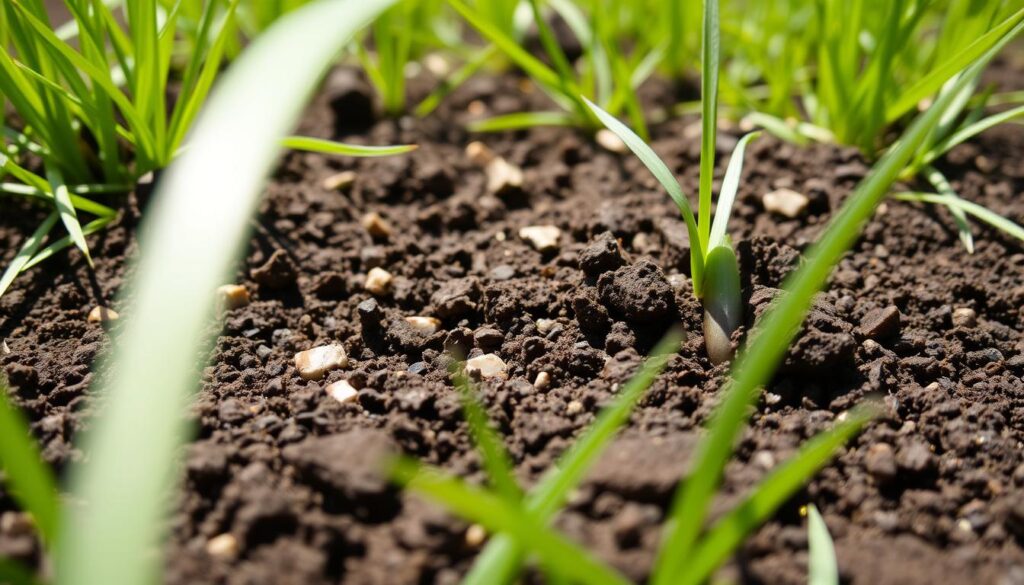
Planting Techniques for Growing Cucumber – Farming
Choosing the right way to plant cucumbers is key to a good garden. You can plant seeds directly or use young plants. Each choice works best under different conditions. Knowing about cucumber planting methods helps you decide what’s best for you.
Direct Seeding vs. Transplanting
Planting seeds directly in the ground has its perks. Cucumbers grow best this way because they don’t like their roots disturbed. Seeds will start to grow in about five days if the soil is warm.
Starting seeds inside and moving them outside is another way, but be careful. It might shock the plants, which slows down growth. If you transplant, use strong, healthy young plants. Choosing disease-resistant types helps too.
Optimal Spacing and Arrangement
Spacing your cucumber plants right is very important. They usually need about 6 feet of space. But if you’re using a trellis, 12 inches apart is enough. This cucumber planting arrangement lets in more light. It also keeps the plants dry, stopping soil diseases.
Using a trellis saves space and makes picking cucumbers easier. You can plant in hills or rows, just keep the right spacing. This helps your plants grow better and gives you more cucumbers. A good plan also helps support the plants as they get bigger.
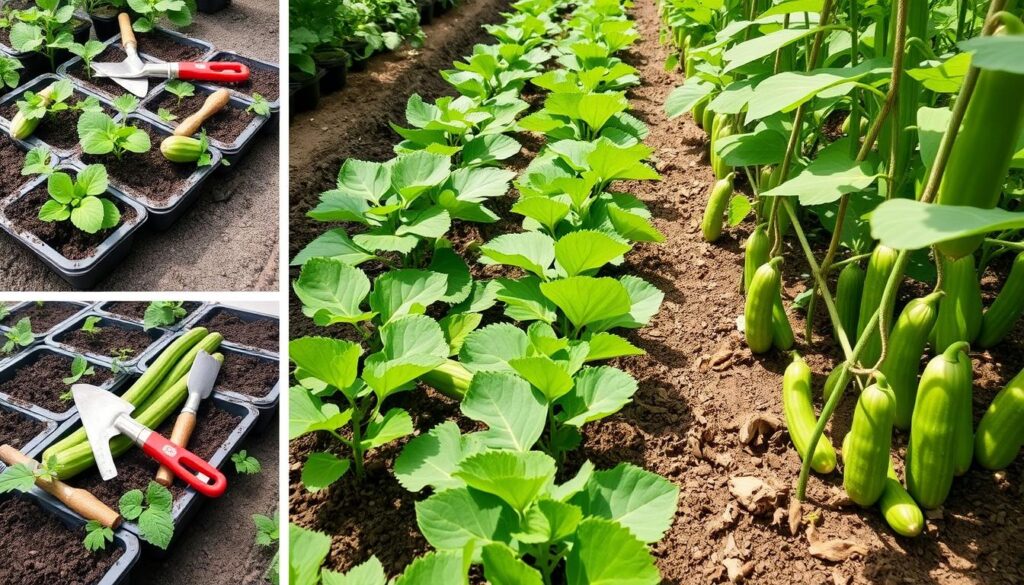
Watering and Care Guidelines for Cucumbers
Cucumbers grow best with steady care, especially in watering and keeping the soil moist. Proper watering helps cucumbers grow healthily, increases the fruit yield, and stops the fruit from getting bitter. Knowing how to water cucumbers right can really help your garden do well.
Importance of Consistent Watering
Cucumbers need at least one inch of water weekly, from rain or watering by hand. Steady watering is key for keeping the soil moist and ensuring strong growth. Changes in water levels can cause:
- Bitterness in cucumbers
- Stunted growth
- More chances of diseases
A drip irrigation system makes watering more effective. It delivers water straight to the roots. This saves water, lowers the risk of too much watering, and helps cucumbers grow evenly. Always check your plants to make sure they’re getting enough water.
Using Mulch to Retain Soil Moisture
Putting cucumber mulch around your plants can really help your watering efforts. Mulch has many benefits for cucumbers, like:
- Keeping soil moisture
- Stopping weeds
- Keeping soil temperature steady
In hot weather, mulch helps keep soil temperature even, which is good for cucumber health. Using organic materials like straw or shredded leaves is a great choice for mulch. It helps the soil keep water and stops diseases from the soil.
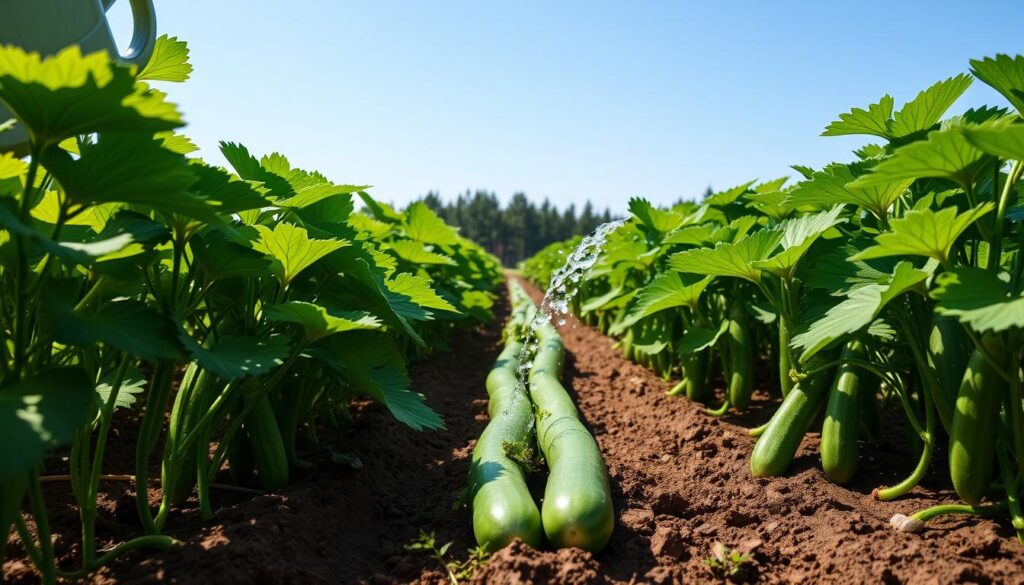
Proper watering and using mulch can create a great environment for cucumbers. This leads to a great harvest.
Pest and Disease Management for Cucumbers
It’s vital to manage pests and diseases for healthy cucumber plants. Different pests can lower your cucumber yield. Diseases may also hurt plant health. Spotting these issues early helps you solve them, giving your cucumbers a better chance to grow well.
Common Pests and How to Control Them
Some major cucumber pests are cucumber beetles, green peach aphids, and melon aphids. To control these pests, use insect netting, release helpful insects, and keep an eye on your plants regularly. For cucumber beetles, you might need safe insecticides. Also, let good bugs settle in your garden. By checking your plants often, you can catch pests early and deal with them more effectively.
Disease Prevention Strategies
Stopping cucumber diseases requires several steps. Some diseases, like powdery mildew, love damp places. To prevent them, make sure your plants have enough air around them. Also, avoid getting leaves wet when you water them. Choosing types of cucumbers that are less likely to get diseases also helps.
Diseases like downy mildew and fusarium wilt grow well in warm, wet areas. So, doing things like rotating your crops is important. Also, getting rid of old plant parts can reduce disease risks.
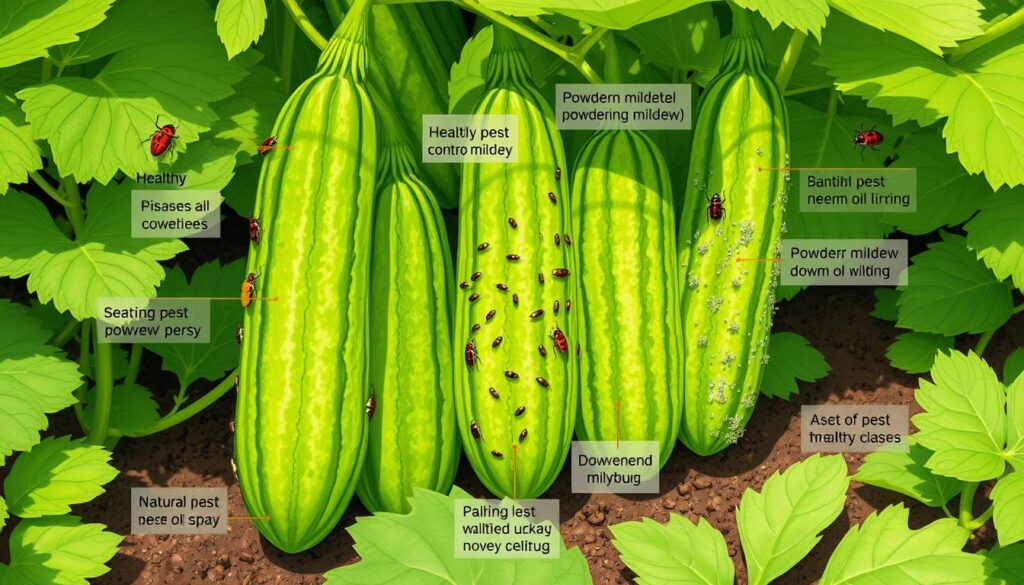
Harvesting Your Cucumber Crop
Picking cucumbers at just the right time is key for the best flavor. You’ll want to know when they’re ready to get the tastiest result. Cucumbers should be picked when they are still firm, completely green, and show no yellow spots. If you leave mature fruits on the plant, it can stop more from growing. So, it’s a good idea to check your plants often when it’s their main growing season.
Signs of Ripeness and When to Harvest
The ideal time to harvest cucumbers varies, but they’re usually ready between 50 to 70 days after you plant them. To tell if they’re ripe, look for these signs:
- Cucumbers should be about 5 to 8 inches long.
- They need to be a rich green color without any yellow patches.
- If you’re picking cucumbers for pickling, they should be 2 to 4 inches long, depending on what you like.
- Remove any damaged fruit to keep the plant healthy.
Proper Harvesting Techniques
Knowing the right way to pick cucumbers helps keep your plants healthy. Follow these steps for a good harvest:
- Use a clean, sharp knife or clippers to cut the fruit from the stem gently. This helps avoid hurting the plant.
- Hold the cucumber carefully while cutting to prevent any damage.
- Look over your plants every couple of days when they’re producing a lot to help them keep making more cucumbers.
Harvesting your cucumbers regularly is important. It makes them taste better and helps your plant grow more flowers and cucumbers. Think about planting different kinds of cucumbers that ripen at different times. This way, you can pick cucumbers throughout the season and enjoy your hard work even more.
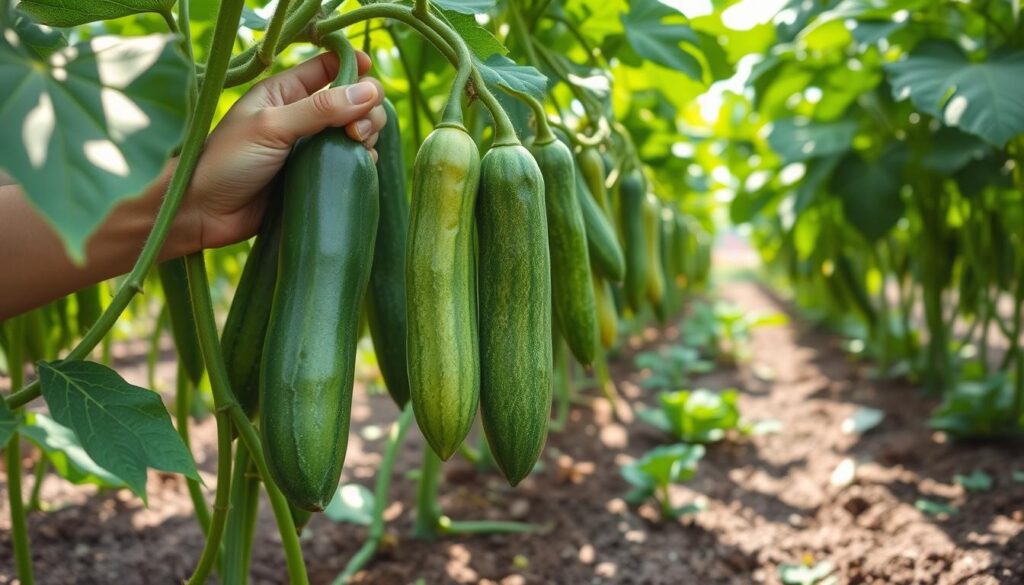
Varieties of Cucumbers for Beginners
When starting your garden, it’s key to pick the right cucumber varieties for beginners. As a newcomer, you will find certain cucumbers easier to care for. Some stand out for their ability to thrive and produce well.
Let’s look at some cucumber types that are great for starting gardeners:
| Cucumber Variety | Type | Growth Habit | Maturity Time (Days) |
|---|---|---|---|
| Marketmore 76 | Slicing | Vining | 60 |
| Boston Pickling | Pickling | Bush | 55 |
| Picklebush | Pickling | Bush | 50 |
| Lemon | Specialty | Vining | 75 |
| Suyo Long | Slicing | Vining | 75 |
| Cucamelons | Specialty | Vining | 60 |
The popular cucumber types mentioned have different growing habits and uses. For instance, Marketmore 76 is praised for its slicing quality. Boston Pickling, on the other hand, is perfect for canning. The Picklebush is great for gardeners with little space, as it does well in containers.
Your local garden center can also provide advice tailored to your area. They can help pick the best cucumber varieties for beginners for you.
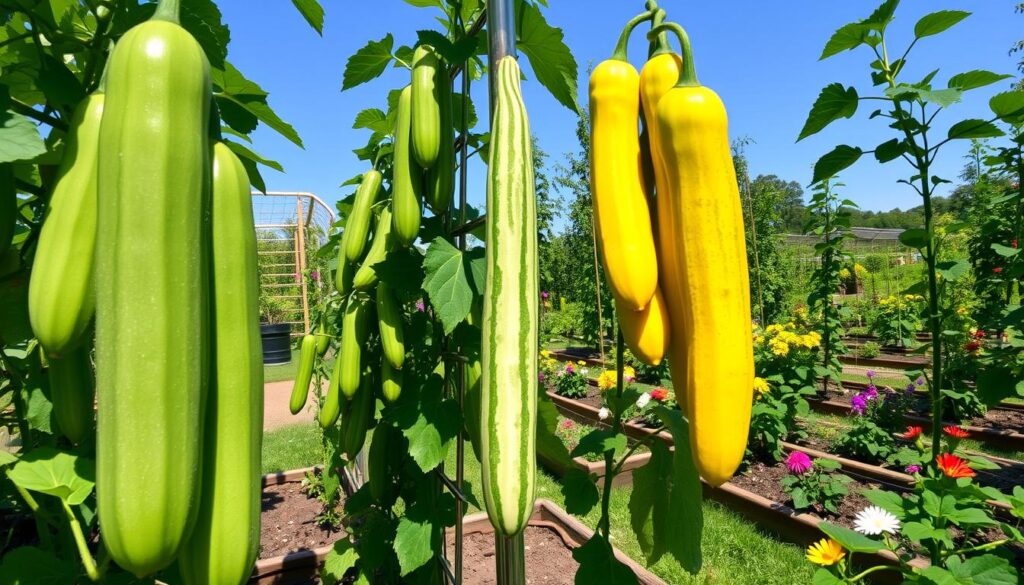
Growing Cucumbers in Containers
If you don’t have much outdoor space, growing cucumbers in containers is a smart choice. Pick bush cucumber varieties for pots to make the most of limited areas. Use pots that can hold 5 to 7 gallons of soil for the best growth.
For vine types, bigger pots are key, at least 14 inches across. This gives roots the room they need. Check that the soil is warm enough, at least 60°F (15°C), before planting. Plant three seeds in each pot, about half an inch deep for best outcomes.
Starting seeds inside for 3 to 4 weeks gives them a head start. Cucumbers need lots of sun, at least eight hours a day, to grow well. In pots, they might need water every day, especially in hot weather. A self-watering pot can keep soil moist without overdoing it.
Adding slow-release organic fertilizer to your soil when planting provides vital nutrients. Also, feeding your plants with liquid kelp or compost tea every 3 to 4 weeks helps a lot. Watch out for pests like cucumber beetles, aphids, and diseases like powdery mildew to keep plants healthy.
Pick cucumbers when they’re not fully grown for the best taste. Pulling on the fruit can hurt the plant, so be gentle. Growing cucumbers in containers is fun and rewarding. It lets you enjoy fresh veggies right at home.
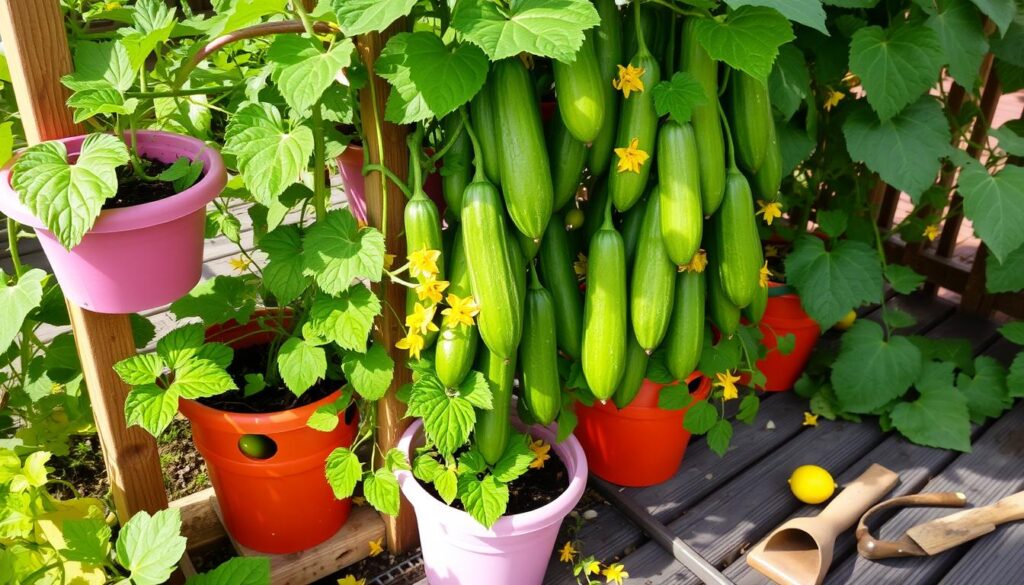
Conclusion
Growing cucumbers is very rewarding. By following best practices, you can get a great harvest. It’s important to know when to plant, the right temperature, and how to deal with pests.
Taking care of your cucumbers from start to finish is key. Use good spacing, strong trellises, and water regularly. This helps your plants grow strong and produce a lot of cucumbers. With the right care, your garden will thrive.
To sum it up, growing cucumbers takes work and knowing what they need. Use these tips to enjoy your gardening and eat fresh cucumbers from your garden. Enjoy the journey and the tasty rewards.

